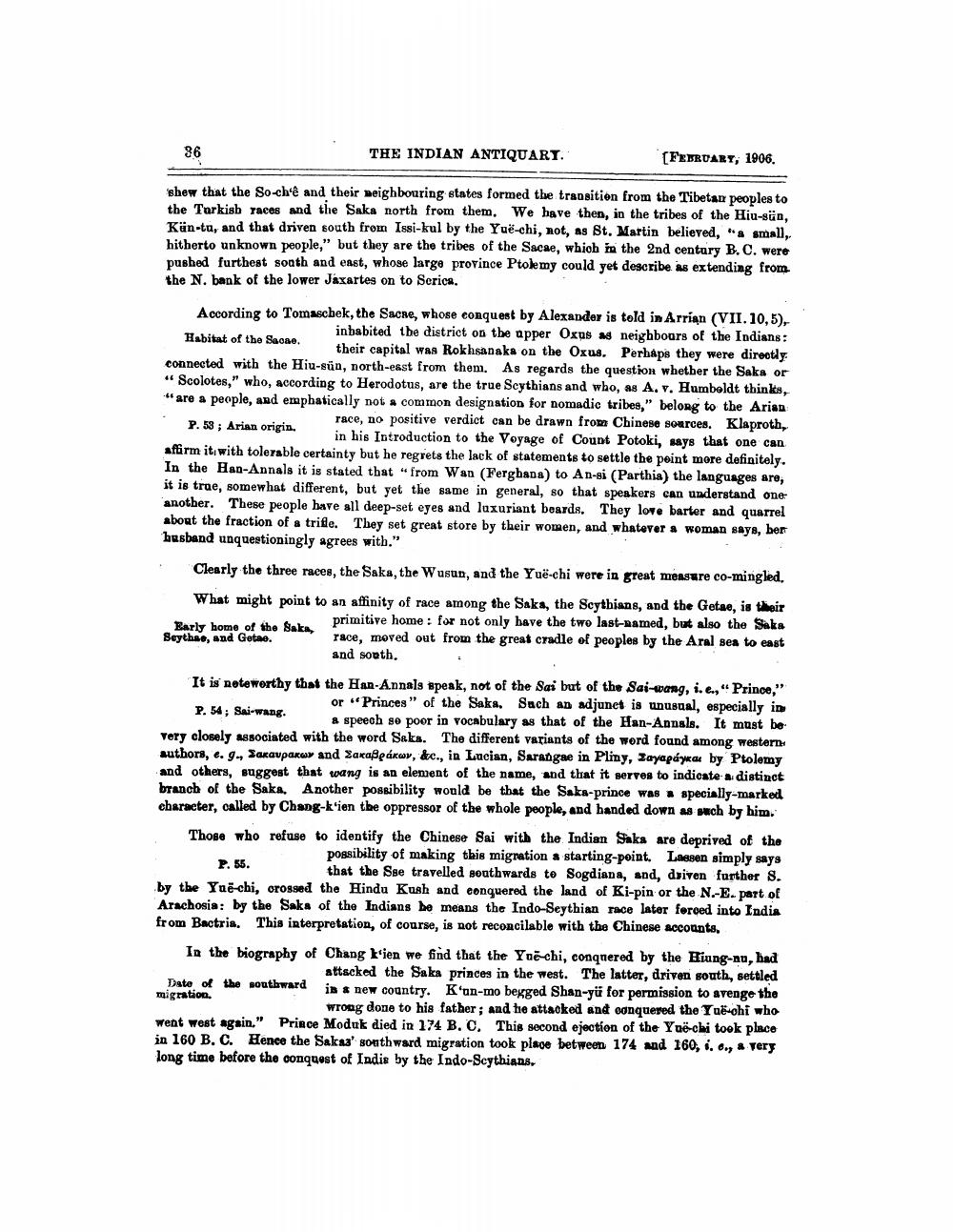________________
86
THE INDIAN ANTIQUART.
(FEBRUARY, 1906.
shew that the So-chê and their neighbouring states formed the transition from the Tibetan peoples to the Turkish races and the Saka north from them. We have then, in the tribes of the Hiu-sün, Kün-ta, and that driven south from Issi-kul by the Yue-chi, not, as Bt. Martin believed, "a small, hitherto unknown people," but they are the tribes of the Sacae, which in the 2nd century B.C. were pushed furthest south and east, whose large province Ptolemy could get describe as extending from the N. bank of the lower Jaxartes on to Serica.
According to Tomascbek, the Sache, whose conquest by Alexander is told in Arrian (VII. 10,5),
inbabited the district on the apper Oxus as neighbours of the Indians: Habitat of the Sacao. their capital was Rokhsanaka on the Oxus. Perhaps they were direotiy connected with the Hiu-sün, north-east from them. As regards the question whether the Saka or "Scolotes," who, according to Herodotus, are the true Scythians and who, as A. v. Humboldt thinks, "are a people, and emphatically not a common designation for nomadic tribes," belong to the Arian P. 53 ; Arian origin.
race, no positive verdict can be drawn from Chinese sources. Klaproth,
in his Introduction to the Voyage of Count Potoki, says that one can affirm its with tolerable certainty but he regrets the lack of statements to settle the point more definitely. In the Han-Annals it is stated that "from Wan (Ferghana) to An-si (Parthia) the languages are, it is true, somewhat different, but yet the same in general, so that speakers can understand one: another. These people have all deep-set eyes and laxuriant beards. They love barter and quarrel about the fraction of a trifle. They set great store by their women, and whatever a woman saya, ber husband unquestioningly agrees with."
Clearly the three races, the Saka, the Wusun, and the Yuë-chi were in great measure co-mingled,
What might point to an affinity of race among the Saka, the Scythians, and the Getae, is their
o primitive home: for not only have the two last-named, but also the Saks Seythee, and Getme.
race, moved out from the great cradle of peoples by the Aral sea to east and south.
It is noteworthy that the Han-Annals speak, not of the Sai but of the Sai-wang, i.e., "Prince,"
or "Princes" of the Saka, Sach an adjunet is unusual, especially in P. 54; Sai-wang.
& speech so poor in vocabulary as that of the Han-Annals. It must be very closely associated with the word Saka. The different variants of the word found among western: authors, e. g., Sakaupare and Saxaßgárm, &c., in Lacian, Sarangae in Pliny, Zayapaysa by Ptolemy and others, suggest that wang is an element of the name, and that it serves to indicate a distinct branch of the Saka. Another possibility would be that the Saka-prince was * specially-marked character, called by Chang-k'ien the oppressor of the whole people, and handed down as such by him. Those who refuse to identify the Chinese Sai with the Indian Suks are deprived of the
possibility of making this migration a starting point. Lassen simply says .
that the See travelled southwards to Sogdiana, and, driven further S. by the Ynë-chi, crossed the Hindu Kush and conquered the land of Ki-pin or the N-E. part of Arachosia: by the Saks of the Indians be means the Indo-Seythian race later forced into India from Bactria. This interpretation, of course, is not reconcilable with the Chinese accounts. In the biography of Chang kien we find that the Yne-chi, conqnered by the Hiung-nu, had
attacked the Saka princes in the west. The latter, driven south, settled Date of the southward in new country. K'on-mo begged Shan-yü for permission to avenge the migration
wrong done to his father; and the attacked and conquered the Yut-ohi who went west again." Prince Moduk died in 174 B.C. This second ejection of the Yoë-cli took place in 160 B. C. Hence the Sakas' sonthward migration took place between 174 and 160, 1. 6. & Tery long time before the conquest of India by the Indo-Scythians,




